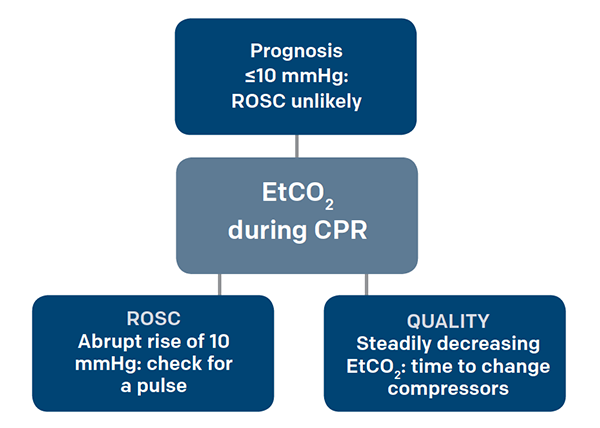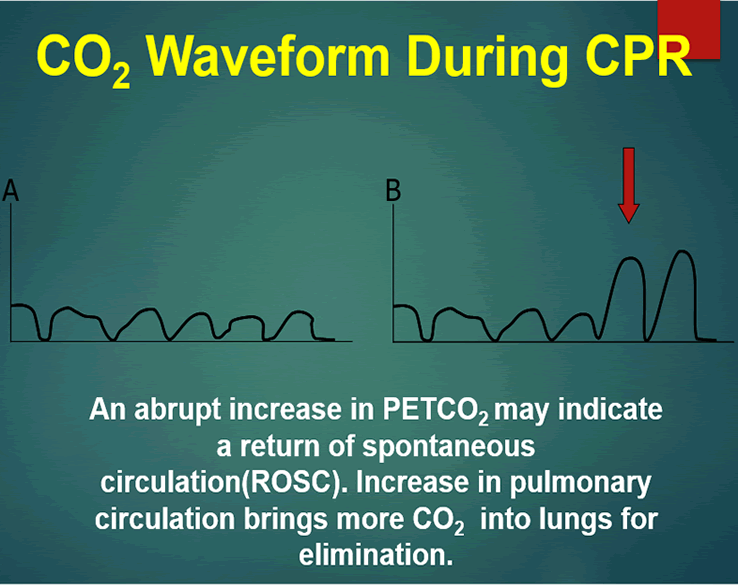low end tidal co2 during cpr
1 evaluating the effectiveness of chest compressions and 2 identification of ROSC. We compared ETCO2-directed chest compressions with chest compressions optimized to pediatric basic life support guidelines in an infant swine model to.

Waveform Capnography Sketchy Medicine
Johnson and Weil 1991.

. 4 to 5 CO2 PetCO2 vs. Capnography may be especially useful in cardiac arrest patients as other conventional markers of endotracheal tube placement may be less reliable in these patients eg auscultation is impossible during cardiopulmonary resuscitation and low CO2 production may make qualitative paper indicators of CO2 difficult to interpret. Association between prehospital cpr quality and end-tidal carbon dioxide levels in out-of-hospital cardiac arrest.
Monitoring end-tidal carbon dioxide during weaning from cardiopulmonary bypass in patients without significant lung disease. During CPR ETCO2 levels were initially high decreased to low levels and increased again at ROSC. Ornato JP Garnett AR Glauser FL.
Another use of ETco 2 monitoring is during procedural sedation and analgesia PSA. A low P a CO2 level is correlated with increased risk of cerebral edema in children with DKA. Weil MH Bisera J Trevino RP Rackow EC.
Thus ETco 2 monitoring is a noninvasive way to measure coronary artery blood flow and return of spontaneous circulation during CPR. During CPR ETCO2 levels were initially high decreased to low levels and increased again at ROSC. Uses during cardiac arrest.
Systematic review and meta-analysis of end-tidal carbon dioxide values associated with return of spontaneous circulation during cardiopulmonary resuscitation. What should end-tidal CO2 be during CPR. J Intensive Care Med.
A low end-tidal CO2 may indicate poor perfusion hypovolemia or sepsis. Cardiac output and end-tidal carbon dioxide. Throughout the resuscitation end-tidal CO 2 was consistently in the 28-36 mmHg range during VFCPR.
Evidence suggests a persistently low ETco 2 value and a widened Paco 2-to-ETco 2 gradient during CPR are associated with poor outcomes. Although the normal range for CO2 should be between 35-45mmHg CO2 monitoring gives healthcare providers a lot more insight into what is going on with a patients condition. 20 mmHg at 20 minutes CPR - higher chance of ROSC.
These levels of CO 2 were consistent with effective chest compression generating reasonable pulmonary blood flow justifying continuation of resuscitation. Gradual fall in ETCO2 suggests compressionist fatigue during CPR - time to change compressionists. Loss of ETCO2 may be the first sign that CPR is needed.
Crit Care Med 198513907-9. In ideal conditions CPR can achieve as much as 25 of normal cardiac output converting the no-flow state of cardiac arrest to a low-flow state Bellamy et al. On the other hand a high CO2 reading may indicate airway narrowing.
Goal is 10 mmHg during CPR. Murphy RA Bobrow BJ Spaite DW et al. Normal ETCO2 in the adult patient should be 35-45 mmHg.
End-tidal carbon dioxide ETCO2 correlates with systemic blood flow and resuscitation rate during cardiopulmonary resuscitation CPR and may potentially direct chest compression performance. Low end tidal co2 during cpr. Measuring end-tidal CO2 in cardiac arrest patients is helpful for confirming tracheal tube placement assessing the effectiveness of chest compressions predicting likelihood of return of spontaneous circulation ROSC in that a persistently low ETCO2 tends to predict death whereas a high or rising ETCO2 is associated with a higher chance of ROSC.
By measuring exhaled CO2 many types of pulmonary assessments can be made. Measurement of a low ETCO 2 value 10 mmHg during CPR in an intubated patient suggests that the quality of chest compressions needs improvement. Abrupt increase in ETCO2 suggests ROSC during CPR detectable before pulse check ETCO2 at 20 minutes of CPR is prognostically useful.
20 mmHg at 20 minutes CPR - higher chance of ROSC. End-tidal carbon dioxide cannot be used to rule out severe injury in patients meeting the criteria for trauma care. This will cause a decrease in the ETCO2 end-tidal CO2 and this will be observable on the waveform as well as with the numerical measurement.
End-tidal CO2 ETCO2 detection requires air movement in and out of the lungs ventilation CO2 production from cellular metabolism and. Carbon Dioxide During the Low Flow State Initiation of CPR During CPR chest compressions along with positive pressure ventilation restore organ perfusion and oxygenation to some extent. More Than Just a Number.
This pattern not previously described is different from that observed in animal and adult cardiac arrest caused by ventricular fibrillation during which ETCO2 decreases to almost zero after the onset of arrest begins to increase after the onset of effective CPR and increases to. End-tidal CO2 EtCO2 is a noninvasive technique which represents the partial pressure or maximal concentration of CO2 at the end of exhalation. Ensure proper rate approximately 100min Ensure proper depth with adequate releaserecoil of thorax 12 thorax or minimum 25 inches Persistently low EtCO.
Normal value is 35-45 mmHg. The first sign of the return of spontaneous circulation ROSC during CPR is increase in ETCO2. Two very practical uses of waveform capnography in CPR are.

3 Waveform Capnography Showing Changes In The End Tidal Carbon Dioxide Download Scientific Diagram

3 Waveform Capnography Showing Changes In The End Tidal Carbon Dioxide Download Scientific Diagram

Capnography During Cardiopulmonary Resuscitation Current Evidence And Future Directions

Waveform Capnography In The Intubated Patient Emcrit Project

The Role Of Etco2 In Termination Of Resuscitation Jems Ems Emergency Medical Services Training Paramedic Emt News

Quantitative Waveform Capnography Acls Medical Training

Waveform Capnography In The Intubated Patient Emcrit Project

Use End Tidal Capnography For Placing Orogastric Nasogastric Tubes And Cpr Page 2 Of 4 Acep Now Page 2

Waveform Capnography In The Intubated Patient Emcrit Project

The Impact Of Ventilation Rate On End Tidal Carbon Dioxide Level During Manual Cardiopulmonary Resuscitation Resuscitation

Reversible Causes Of Low Etco2 In Cpr Criticalcarenow

Etco2 Valuable Vital Sign To Assess Perfusion The Airway Jedi

Cpr Mobile Code Stand With Capnograph Capnography
Emdocs Net Emergency Medicine Educationcapnography In The Ed Emdocs Net Emergency Medicine Education

Capnography Provides Bigger Physiological Picture To Maximize Patient Care Jems Ems Emergency Medical Services Training Paramedic Emt News

Reversible Causes Of Low Etco2 In Cpr Criticalcarenow

Capnography Provides Bigger Physiological Picture To Maximize Patient Care Jems Ems Emergency Medical Services Training Paramedic Emt News
What Is Capnography Capnoacademy Capnoacademy

Average Etco2 Kpa During Cpr In Patients With Or Without Rosc Download Scientific Diagram